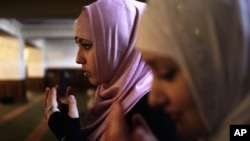At the entrance to a school in Grozny, the capital of Russia’ s Chechen republic, two security guards grip their guns as they order a woman to cover her head before walking into class.
“ You can’ t go inside with your head like that,” one of them yells, tapping his AK-47.
The young student rumbles inside her purse before pulling out a black silk scarf.
“Is this better?” she asks, covering up her entire head with the scarf, matching her kohl-lined
eyes.
Under the Russia-backed leader Ramzan Kadyrov, Chechnya is swiftly becoming a conservative Muslim state, a sharp change from the officially atheist Soviet Union when women in the Caucasus burnt their headscarves. Many Chechen women here are the first in three generations to cover their heads.
Slideshow of Diana Markosian's photos
This has coincided with the almost complete disappearance of the ethnic Russian population in Chechnya. At the time of the Soviet collapse, 20 years ago, ethnic Russians account for 30 percent of Chechnya's population. Today, they are less than one percent.
But now, “the headscarf is a symbol of purity and worth,” says Malika Omarova, head of the
Union of Chechen Women in Grozny. “ When I was a student, I never wore a headscarf, not one person forced me. But, I want our women to wear them - it is in our blood. That is what makes us Chechen.”
The Russian republic of Chechnya has seen two brutal separatist wars in the last two decades, with atrocities committed by both rebels and Moscow’ s federal forces.
Strongman Ramzan Kadyrov, a former rebel who changed sides after the first war, has brought a semblance of stability to Chechnya, helped by massive investment by the Kremlin. But this stability is matched with a resurgence of Islamic belief and practice.
In today’s Chechnya of cafes and fashion boutiques, the mandatory headscarf symbolizes this Islamic revival.
“ Chechnya is already among one of the world's most repressive societies, with the state
controlling almost every aspect of daily life," wrote Jennifer Windsor of Freedom House in a
report on Chechnya.
The battle is being played out in universities, state buildings and now in the street, where a wave of attacks last year took place on women for not wearing headscarves. Kadyrov denies his men were involved.
“ I don’ t know [who they are], but when I find them I shall announce my gratitude,” Kadyrov told the state-run regional television channel Grozny. He called the victims of the paintball attacks “ naked women” who had most likely been forewarned. “ Even if they were carried out with my permission, I wouldn’ t be ashamed of it,” he said of the paint-ball attacks.
Kadyrov’ s efforts to enforce a dress code have angered rights activists in Moscow who say such rules violate Russia’ s constitution.
But few women dare to challenge Kadyrov's rule in this southern border region of more than one million people.
Zalina, a 19-year-old student and hair stylist, says wearing a headscarf is not really a choice.
“ I don’ t see the point in wearing it,” says the student, whose long dark hair flows out from under her head covering. “But if I don’ t, I know I will be punished. I am scared of that.”












